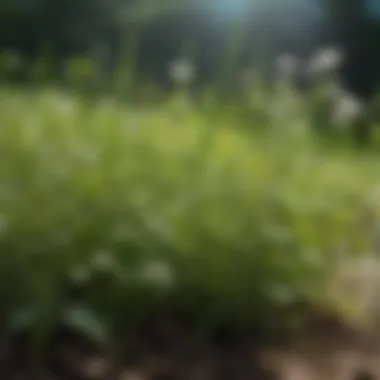Managing Weeds for a Healthy Lawn


Intro
The battle against weeds is a common struggle for many homeowners, especially those who take pride in their lawns. A lush, green yard may seem like an important feature of a home, but the insidious creep of weeds can quickly tarnish that vision. This article takes a deep dive into understanding why weeds proliferate in lawns, including the myriad environmental conditions that encourage their growth, and offers practical solutions that every homeowner can easily implement. Knowing the intricate interplay between grass types and weed species can arm you with the necessary tools to manage and prevail over this persistent issue.
The Relationship Between Grass and Weeds
To comprehend why weeds thrive, it's important to first understand how they interact with grass. Weeds often compete for resources such as sunlight, water, and nutrients—which essentially puts them at odds with your carefully nurtured lawn. Some types of grass may struggle to outcompete aggressive weeds, especially when they are not suited to the local climate or soil conditions.
Interestingly, certain weeds can even signal problems within your lawn. For example, if you notice a proliferation of dandelions, it might mean your soil is overly compacted. On the other hand, a patchy lawn often garners a diverse crowd of annual weeds, revealing that aspects such as overseeding or fertilization may need reevaluation. The relationship between grass and weeds, therefore, is both adversarial and revealing.
Environmental Factors at Play
Weeds don’t grow in a vacuum. Various environmental factors can significantly contribute to weed proliferation:
- Soil Quality: Poor quality soil lacking in nutrients can allow opportunistic weeds to flourish. Testing your soil can help you determine what nutrients may be lacking.
- Sunlight: Weeds thrive in sunlight. If your lawn is shaded by trees or structures, those sunny spots often become a target for weeds.
- Moisture Levels: Both excessive water and dry conditions can favor different types of weeds.
- Grass Type: Some grass types are more resilient against weeds. For instance, fescue tends to be more competitive against many common weed species.
Understanding these environmental influencers allows homeowners to take action accordingly, improving not just the look of their lawn, but its overall health.
Practical Solutions for Managing Weeds
Arming yourself with knowledge is key, but what about taking action? Here are some strategies to help keep those weeds at bay:
- Regular Lawn Maintenance: Mowing often helps prevent weeds from growing too tall or going to seed. Keeping the blades sharp ensures a clean cut, which can strengthen grass and reduce the chances of weeds.
- Proper Fertilization: Use fertilizers that cater specifically to your grass type. Over-fertilization can lead to fast-growing weeds that outstrip your grass, while under-fertilization can weaken your lawn’s defenses.
- Aeration: Aerating the soil improves nutrient and water penetration, benefitting your grass and making it harder for weeds to establish themselves.
- Mulching: In garden beds and around shrubs, a good layer of mulch can smother weeds and retain moisture.
- Hand-Pulling and Spot Treatments: Sometimes, the direct approach is the best. Hand-pulling is effective for certain types of weeds, while targeted applications of herbicides can address more pervasive issues.
"An ounce of prevention is worth a pound of cure." This age-old adage rings particularly true in the context of lawn care.
Culmination
Weeds can be more than a mere nuisance; they act as indicators of the overall health of your lawn. Recognizing the factors that contribute to their growth—and understanding the relationship between your grass and these relentless interlopers—equips you with valuable insight. From improving soil quality to regular maintenance and using effective weed management strategies, knowledge combined with action can lead to a healthier, more beautiful lawn. Through enlightened practices, you can reclaim your space from the grip of weeds and allow your grass to thrive.
For more information, resources such as Britannica and Wikipedia offer insights into lawn care practices. Join discussions on community forums like Reddit where fellow gardening enthusiasts share their struggles and triumphs.
Prelude to Weeds in Lawns
Growing a lush, green lawn isn’t just about planting grass seeds and hoping for the best. It’s a delicate balance of nurturing the right plants while keeping invaders at bay. Weeds can be a major nuisance, and their presence can indicate underlying issues in lawn health. Understanding the factors that allow these unwelcome guests to thrive is crucial for any homeowner looking to maintain a beautiful yard.
Defining Weeds
So, what exactly is a weed? In most straightforward terms, a weed is simply a plant growing where it isn’t wanted. This might seem overly simplistic, but it underscores a key point: even a pretty flower in the wrong spot can be a weed. The definition hinges not on the intrinsic qualities of the plant, but rather its context within your lawn.
There are various types of weeds—some, like dandelions or clover, are broadleaf intruders, while others, such as crabgrass, mimic lawns with their grassy appearance. These plants are often hardy, adaptable, and can outcompete the grass for resources when conditions turn favorable. Understanding what constitutes a weed helps homeowners take decisive action before these plants monopolize precious nutrients and space.
Understanding the Impact of Weeds
Weeds are more than just unsightly—they can have serious consequences for your lawn. First off, they compete fiercely with grass for nutrients and water. Instead of your grass thriving, weeds can rob it of the space and resources it needs. This can lead to patchy growth and a compromised aesthetic. Moreover, certain invasive weed species can harbor pests and diseases, which may further jeopardize the health of your grass.
"A lawn littered with weeds is a lawn that struggles to breathe."
In addition to their physical impact, the presence of weeds signals deeper issues within your lawn. For instance, persistent weed problems may point to poor soil health or inadequate care. Homeowners might find themselves trapped in a cycle of trying to combat visible weeds, yet failing to address the root causes.
In summary, understanding weeds is pivotal for fostering a robust lawn. Identifying them not only empowers homeowners to tackle the immediate problem but opens a window to explore the overall health of their greenspaces. By addressing the nuances of weed proliferation, one can reshape the lawn into a vibrant, lush oasis.
Grass and Weeds: A Competitive Relationship
Understanding the relationship between grass and weeds is crucial when considering the dynamics of lawn upkeep. Weeds can seem like pesky intruders, but in reality, they thrive on the same resources your lawn does: nutrients, water, and light. Knowing how these two compete can lead you to better strategies in managing your lawn. If we grasp this competition, it can shed light on why certain weeds appear and how to effectively control them.
Nutrient Competition
Nutrient competition is a fundamental aspect influencing the health of both grass and weeds. When nutrients are plentiful in the soil, grasses have a better chance of establishing themselves and thriving. However, if the soil lacks vital elements, weeds often take the upper hand. Weeds like dandelions or clover can flourish in depleted soil, quickly monopolizing essential nutrients necessary for grass health.
- Nitrogen, Phosphorus, and Potassium: These are the big three nutrients that significantly affect growth. A deficit in any of these can tip the scales in favor of weeds.
- Soil Testing: Conducting a soil test is a wise first step. This highlights nutrient deficiencies and pH levels that can impact your lawn’s prosperity.
- Fertilization Awareness: Over-fertilizing can lead to a lush lawn but may also inadvertently promote weed growth, especially if the surplus isn't addressed properly.
Addressing nutrient levels appropriately can keep grass strong and manage the weed population effectively.
Water Accessibility
Water is another battleground where grass and weeds vie for dominance. Lawns require consistent and adequate moisture to flourish, while weeds often have deep roots that can extract water from lower soil layers. This factor makes it critical to establish sound watering practices.
- Deep Watering vs. Frequent Light Watering: Deep watering encourages root growth in grass, making it resilient against weeds. Conversely, frequent light watering can lead to shallow root systems, leaving grass vulnerable.
- Drought Conditions: In dry spells, weeds can appear to be hardy simply because they are better equipped at surviving in adverse conditions. Keeping grass healthy through proper watering can mitigate this.
Understanding the intricacies of water accessibility ensures that grass receives the hydration it needs while keeping weeds at bay.
Light Exposure


Light exposure is yet another critical factor in the grass-weeds dynamic. Grass typically thrives in sunny areas, but weeds can often establish in shadier spots or where grass is sparse. When there’s limited light, weeds may flourish, undermining the effort put into maintaining a lush lawn.
- Density of Grass: Thick grass can shade soil effectively, hindering weed seed growth and germination. The denser your grass, the less opportunity weeds will have to sprout.
- Seasonal Changes: Seasonal variations impact light levels. In shaded areas, certain aggressive weeds can take hold, making it crucial to manage light exposure through appropriate mowing and landscape placement.
Grasping how light influences both grass and weeds helps in strategizing effective lawn care techniques to keep unsightly weeds at bay.
"Successful lawn care is about creating an environment where grass can thrive, making it difficult for weeds to encroach. "
In summary, recognizing the competitive interaction between grass and weeds on multiple fronts—nutrient-rich soil, accessible water, and optimal light exposure—sets the foundation for effective lawn management. This knowledge is instrumental for homeowners in achieving a balanced and thriving lawn.
Common Types of Weeds Found in Lawns
When it comes to understanding weed proliferation, identifying the common types of weeds that invade residential lawns is crucial. Each type of weed brings its own unique characteristics and challenges. Ignoring this aspect can hinder effective management and control measures. A well-informed homeowner gains the upper hand in lawn maintenance by recognizing these weeds.
Broadleaf Weeds
Broadleaf weeds are among the most recognizable culprits in lawns. They typically exhibit wide leaves that set them apart from grass. Common examples include dandelions, clover, and plantain. These weeds can be a nuisance not just because of their appearance, but also due to their robust growth patterns. Broadleaf weeds tend to thrive in nutrient-rich soil, which means that a flourishing lawn could ironically support their growth.
Why they matter: The presence of broadleaf weeds can indicate underlying issues within your lawn's health. Their ability to produce numerous seeds means a single plant can quickly turn into an infestation if not managed. Furthermore, they can compete with desirable grass varieties for resources, ultimately undermining the aesthetics and integrity of your lawn. Effective management often involves targeted approaches that avoid harming the surrounding grass.
Grassy Weeds
Grassy weeds pose a different set of challenges in lawn care. Unlike broadleaf weeds, these usually have narrow leaves and grow in tufts. Common varieties include crabgrass, goosegrass, and quackgrass. They have the ability to outcompete fine turf grasses, especially in compromised lawns where competition for sunlight and nutrients becomes fierce.
Importance of recognition: Differentiating grassy weeds from desirable grass types is essential for effective control. Misidentification can lead to unnecessary treatments that might not address the core problem. For instance, attempting to use broadleaf herbicides on grassy weeds can be futile and might cause more harm to your prized grass. Understanding the specific grassy weeds in your lawn enables more precise and effective interventions, leading to healthier lawn conditions long-term.
Sedge Weeds
Sedge weeds can often be mistaken for grass due to their similar appearance, yet they're distinct in many important ways. These weeds, which include species like yellow nutsedge and purple nutsedge, thrive in moist conditions and can proliferate very quickly. Their triangular stems and tough growth make them hard to eliminate.
Noteworthy considerations: Sedge weeds not only compete for nutrients but they can also be particularly aggressive in taking over lawn spaces. It's vital to recognize their unique growth habit and reproductive strategies, which often involve both seed production and vegetative means like tubers. Homeowners should focus on reducing moisture levels and employing targeted herbicides specifically designed for sedge control.
"A weed is but an unloved flower." This showcases the complexity of weeds; understanding their types is the first step in loving your lawn back.
In summary, recognizing the common types of weeds in your lawn is a vital step toward effective management. Whether it’s broadleaf, grassy, or sedge weeds, each type requires a tailored approach for control. A keen eye and willingness to learn can transform a weed-infested yard into a thriving green space.
Identifying Causes of Weed Infestation
Understanding the causes of weed infestation is crucial in managing and preventing unwanted plant growth in lawns. By pinpointing the specific triggering factors, homeowners can implement proactive and effective strategies to create a more resilient grass environment. Ignoring these causes can lead to a good amount of frustration and an uphill battle against weeds, ultimately resulting in a lawn that looks more like a patchy meadow than a beautiful yard. This section will dive into the primary reasons why weeds thrive, which can empower you to take charge of your lawn care practices.
Poor Lawn Health
A healthy lawn is like a fortress; its strong defenses prevent invaders—like weeds—from taking hold. Poor lawn health often arises from a combination of disease, inadequate fertilization, and pest damage. If your grass is under stress from these factors, it becomes an inviting place for weeds, who can perform well in conditions where the grass is struggling.
To address this, regular lawn maintenance is essential. Here are some helpful steps:
- Fertilize properly: Not too much, not too little—find that sweet spot! A balanced fertilizer helps grass outcompete weeds.
- Aerate the soil: Aeration improves root growth, allowing grass to better absorb nutrients and water.
- Identify pests: Keep an eye out for grubs or other pests that could weaken your grass.
Compacted Soil
When soil is compacted, it’s like a tightly packed suitcase, leaving no room for air and moisture. Compacted soil limits access to essential nutrients and inhibits healthy root development, allowing weeds to outshine grass in those tough spots. Lawns that experience heavy foot traffic, such as play areas for children or pets, are more prone to this issue.
To combat compacted soil, consider these actions:
- Aerate your lawn: Use a core aerator to create holes in the soil, which can rejuvenate root systems.
- Limit traffic: Designate paths or areas for walking to minimize compaction.
- Apply organic matter: This improves soil structure and provides vital nutrients.
Inconsistent Watering Practices
Watering might seem simple, but inconsistency can lead to chaos in your lawn. Too little water stresses your grass, while too much can encourage weed growth, particularly those hardy types that thrive in saturated conditions. Weeds often have more resilience to droughts than grass does, which can lead to their increased proliferation.
To optimize watering:
- Set a schedule: Regular watering during dry periods promotes robust grass growth.
- Check the soil: Ensure your lawn is getting adequate moisture; a soil moisture meter can be a helpful tool.
- Early morning watering: Watering in the early morning allows for maximum absorption and minimizes evaporation.
Improper Mowing Techniques
Mowing might seem straightforward, but incorrect practices can open the door to weeds. Cutting grass too short can thin out the canopy, letting sunlight in for weeds to germinate and flourish. Additionally, using a dull mower blade can damage grass, making it susceptible to pests and diseases.
Here are some basic guidelines for mowing:
- Keep grass height at a moderate level: Aim for about 3 inches. Shorter than that? You’re inviting trouble.
- Sharpen mower blades regularly: A clean cut helps the lawn recover faster and discourages weed growth.
- Change mowing patterns: Altering your mowing direction can prevent compacted patterns and encourage upright growth.
By recognizing these causes and taking appropriate steps, lawn care can become a more straightforward process, leading to healthier grass and a thriving yard.
Environmental Factors Contributing to Weeds


Understanding the environmental factors that contribute to weed proliferation is essential for homeowners striving to maintain a healthy lawn. Numerous elements interplay in creating optimal conditions for weeds to thrive. From climate variations to soil health, each factor plays a pivotal role in weed dynamics. Homeowners should be aware of these aspects, as addressing them can lead to significant improvements in lawn quality and reduce the prevalence of unwanted plants.
Climate Conditions
Weather conditions greatly impact the growth of both grass and weeds. Regions with mild, wet winters and warm summers often see an explosion of weed growth because these conditions favor many weed species. For instance, dandelions may flourish in temperate climates where they can produce seeds in abundance before the first frost.
Moreover, the temperature and rainfall patterns in your area will determine not just whether weeds can sprout, but how aggressive they become.
- A few points to consider:
- Warmth encourages growth: Weeds tend to germinate faster than grass seeds in warm conditions.
- Moist environments: Prolonged rainfall or excessive moisture in the soil creates a hospitable setting for invasive species.
Adapting lawn care strategies to the climate can effectively manage these issues. For example, timing your seeding for cooler temperatures can outsmart some persistent weeds.
Soil pH and Fertility
Soil composition is another essential factor in weed proliferation. Different weeds prefer different pH levels, which influences their ability to survive and compete against grass. Generally, a pH level between 6.0 to 7.0 is optimal for most grass types. If the soil leans too acidic or alkaline, then the grass may be weakened, allowing opportunistic weeds to take root.
Furthermore, the fertility of the soil also plays a crucial role. Nutrient-rich soil can support healthy grass, making it difficult for weeds to establish themselves. However, when soil becomes depleted of nutrients, it turns into a magnet for weeds which can better tolerate poor soil conditions.
- Key actions:
- Regular soil testing: It helps you understand what nutrients your soil needs and allows for appropriate amendments.
- Maintain balanced nutrients: Applying organic compost can add vital nutrients while also improving soil structure.
A proactive approach to soil health can make your lawn less appealing to weeds.
From Drought to Flooding
Weeds are incredibly resilient, often bouncing back from environmental stresses that might devastate other plants. Both extreme drought conditions and unexpected flooding can drive weeds to dominate an area. During prolonged dry spells, grass may struggle to survive, while many drought-resistant weeds like pigweed can thrive, often taking over the thinning lawn. Conversely, a sudden influx of water can lead to soggy patches where weeds multiply swiftly, capitalizing on the immaculate moisture.
"No matter the environmental challenge, there is usually a weed waiting for an opportunity to invade."
In addressing these extremes, it is important to establish effective watering practices and consider drainage options. Homeowners should be vigilant about:
- Adjusting watering schedules: This ensures grass maintains its health during dry spells.
- Implementing drainage solutions: This can help prevent flooding in susceptible areas of the lawn.
In summary, recognizing and addressing these environmental factors can significantly contribute to a weed-free lawn. With the right information and strategies, homeowners can foster a thriving lawn that stands resilient against noxious invaders.
Efficient Lawn Care Strategies to Minimize Weeds
A well-tended lawn isn't just about aesthetics; it's about creating an environment that discourages weed growth. Efficient lawn care strategies are the backbone of this effort. When we talk about minimizing weeds, it's crucial to appreciate the multifaceted nature of lawn care—every factor, from soil health to mowing practices, plays a role.
When homeowners take the time to implement these strategies, they observe numerous benefits. Firstly, a healthier lawn naturally chokes out weeds, reducing reliance on chemical treatments. Secondly, the time and resources spent on repeatedly addressing weed issues can be redirected towards creating a vibrant and enjoyable outdoor space. Ultimately, a proactive approach builds a lush lawn that stands as a testament to the homeowner's diligence and care.
Soil Testing and Amendment
Understanding the unique composition of your soil lays the groundwork for effective lawn care. Conducting a soil test reveals nutrient levels and pH balance, essential for grass health. When soil lacks necessary nutrients, grasses weaken and become vulnerable, giving way to weeds that thrive in poor conditions.
Soil amendments, including the addition of organic matter or adjusting pH levels, can transform your lawn. For instance, adding compost not only enriches the soil but also improves its structure, which benefits root development. You must take into account local soil conditions—some areas may require lime to adjust acidity, while others might benefit from sulfur. By investing in soil health, you're laying the future for your lawn.
Proper Fertilization Techniques
Fertilization is not simply about tossing some granules on the lawn and hoping for the best. Effective fertilization involves precision—understanding the right type of fertilizer and the optimal times for application. Slow-release fertilizers tend to suit lawns better because they provide nutrients over time, reducing the risk of runoff, which can enhance weed populations elsewhere.
Incorporating a fertilization routine based on soil tests can also maximize efficiency. A common mistake is to over-fertilize, leading to lush growth not for grass, but for weeds, too. Balancing nitrogen, phosphorus, and potassium is key. A simple rule of thumb—keep to the recommended rates on the fertilizer bags, and don’t be tempted to overdo it. This practice helps maintain grass vigor, creating a more competitive environment against weeds.
Effective Watering Approaches
Watering may seem straightforward, but techniques matter. Lawns need deep watering rather than frequent shallow doses. Shallow watering encourages roots to stay near the surface, making them susceptible to drying out and more likely to yield to weeds. On the flip side, deep watering promotes robust growth and resilience against invasive plants.
Additionally, keep an eye on the timing of your watering. Early morning is the prime time—temperatures are generally cooler, reducing evaporation rates, and giving the grass time to dry out before nightfall, which minimizes disease risks.
Strategic Mowing Practices
Mowing might just seem like a routine chore in lawn care, but it's a game changer in weed control. Keeping the grass at the right height can significantly impact its ability to fend off weeds. Generally, longer grass shades the soil, restricting sunlight that weeds desperately need to sprout.
Moreover, maintaining sharp and clean mower blades prevents tearing and tearing can provide entry points for pests and diseases. Mowing too low is another pitfall; this can stress the grass, making it weaker and more prone to invasion. Stick to the rule of cutting no more than a third of the grass height at a time.
Strategies converge here—if you focus on soil health, proper fertilization, effective watering, and adept mowing, the cumulative effect creates a thriving grassy ecosystem.
"A proactive approach to lawn care not only improves health and appearance but fundamentally reduces weed proliferation."
By adopting these efficient lawn care strategies, you're not just managing weeds; you're actively cultivating your patch of green into an inviting corner of your home, designed to flourish year after year.
Weed Control Methods: Chemical vs. Organic Approaches


In the ongoing battle against weeds, homeowners often find themselves at a crossroads between chemical solutions and organic alternatives. Both methods boast their own strengths, weaknesses, and considerations that warrant a thoughtful approach. By understanding these weed control methods, readers can make informed decisions that align with not only their lawn care goals but also personal values regarding environmental impact.
Understanding Herbicides
Herbicides, the go-to chemicals for many lawn warriors, are designed to eradicate or inhibit the growth of unwanted plants. They come in two main types: selective and non-selective. Selective herbicides target specific types of weeds while leaving grass unharmed. On the other hand, non-selective herbicides wipe out everything in their path, which can be a double-edged sword depending on the user's intention.
When applying herbicides, it's crucial to comprehend the specific active ingredients involved. Some common herbicides include glyphosate and 2,4-D. These substances work through different mechanisms, making it essential to choose the right one for the specific weed problem at hand. Users must carefully follow application instructions to avoid harming desirable plants or negatively affecting soil health.
Considerations when using chemical herbicides:
- Timing: The effectiveness can hinge on the season, with some weeds being more vulnerable in specific weather conditions.
- Safety: Always wear protective gear and consider the potential impact on pets and local wildlife.
- Soil Health: Prolonged use may lead to detrimental effects on soil microorganisms.
Natural Alternatives for Weed Control
For those who lean towards a more sustainable approach, natural methods for weed control provide effective options without chemical reliance. Organic alternatives range from cultural practices to homemade remedies.
- Mulching: A layer of organic material, such as wood chips or straw, can smother weeds while nourishing the soil as it decomposes. This simple method not only suppresses weed growth but also retains moisture—two birds with one stone.
- Boiling Water: An age-old remedy, pouring boiling water directly onto weeds can effectively kill them without introducing harmful substances into the ecosystem.
- Vinegar: The acetic acid in vinegar can desiccate weeds. However, it’s best used on sunny days for optimal effect, ensuring the weeds absorb the heat and acidity.
- Hand Pulling: While labor-intensive, this method removes the entire root, significantly reducing the chance of regrowth. Frequent hand pulling, especially before the flowering stage, can significantly lessen weed populations over time.
Organic methods often require a bit more patience and can be less immediately dramatic than chemical solutions, but the long-term benefits often outweigh the initial effort.
Ultimately, opting for organic alternatives not only fosters a healthier lawn but also aligns with a growing awareness of environmental stewardship. Homeowners who choose to go this route contribute to a more sustainable landscape while reaping the rewards of a well-maintained lawn.
As we consider both methods—chemical and organic—it becomes clear that the choice ultimately resides with the homeowner. An educated decision can lead to a thriving lawn and cultivate a deeper understanding of the natural balance between grass and weeds.
Long-Term Prevention of Weeds in Lawns
Weeds can be a thorn in the side of any homeowner who takes pride in their lawn. Understanding long-term prevention is crucial not only to maintain a green, healthy yard, but also to save time and effort on constantly battling these invaders. Effective weed management is less about quick fixes and more about fostering an environment where grass thrives and weeds struggle to take root. A well-cared-for lawn can be your pride and joy, acting as a centerpiece for gatherings without the unsightly interruption of weeds.
Establishing Healthy Grass Growth
Healthy grass is the first line of defense against weeds. By choosing the right grass type for your climate and soil conditions, you can ensure a dense lawn that is resistant to invasion. A robust lawn outcompetes weeds by choking them out of their sunlight, water, and nutrients. Establishing strong roots is critical. For instance, when you seed or overseed, make sure to choose quality seeds that are suited to your local environment. It's not just about planting; it's also about maintaining proper lawn care. Regular mowing, proper watering – ideally in the morning – and nutrient application through natural fertilizers will keep grass sturdy and flourishing.
- Select grasses that are suitable for your specific climate.
- Water regularly but avoid overwatering to reduce soil compaction.
- Use mulch around garden beds to conserve moisture and suppress weeds.
Maintaining Soil Structure
The health of your lawn’s soil is equally important. Soil compaction can create an environment where weeds thrive. Aeration helps to improve airflow, water, and nutrient absorption. It can make a world of difference – allowing roots to penetrate deeper and access the resources they need. Moreover, conducting soil tests allows you to identify nutrient deficiencies or imbalances in pH levels, tailoring your amendments accordingly.
"Healthy soil equals a healthy lawn. If your soil isn't happy, your grass won't be either."
Here’s a quick checklist to maintain your soil:
- Aerate your lawn once or twice a year.
- Test your soil every few years to adjust nutrients as needed.
- Incorporate organic matter, such as compost, to improve soil health.
Creating Barriers Against Weeds
Prevention tactics aren’t just about what’s beneath your grass but also include the physical barriers that can limit weed proliferation. This can be as simple as using landscaping fabric or mulch beds. These barriers impede sunlight and moisture access for weed seeds. In addition, cultivating a dense grass stand can reduce the chances of weed seed germination, as fewer bare spots exist for them to settle into.
- Install landscaping fabric in flower beds.
- Use mulch to smother weed seeds in garden areas.
- Plant ground cover plants that are hardy and act as a living mulch.
In essence, the long-term prevention of weeds in your lawn boils down to establishing strong, healthy grass, ensuring your soil is well-maintained, and implementing physical barriers to thwart weed growth. By taking these steps, you foster a lovely lawn that enhances your property value and keeps your exterior looking sharp.
End: Achieving a Balanced Lawn
In the fight against weeds, the conclusion serves as the lighthouse guiding homeowners towards a well-balanced lawn. A comprehensive understanding of weed proliferation not only offers insights into what makes these unwanted plants thrive but also enables individuals to cultivate a harmonious environment for their grass. Several key elements play a role in achieving this balance, including effective lawn care practices, understanding soil health, and recognizing the symbiotic relationship grass has with the ecosystem.
The benefits of striving for a balanced lawn are manifold. Firstly, it leads to healthier turf, resulting in a more visually appealing landscape. A robust lawn serves as the first line of defense against weed infestation. Secondly, a well-maintained lawn contributes to environmental stability by supporting local wildlife and maintaining the natural habitat. A healthy lawn also helps in reducing soil erosion and improving air quality, showcasing its critical role in the ecological web.
When considering the journey to a balanced lawn, several factors warrant focus:
- Understanding nutrient cycles and their impact on grass health.
- Implementing proper irrigation techniques to ensure adequate moisture levels.
- Staying vigilant about potential threats from pests or diseases, which can weaken grass and open the door for weeds.
Supporting these elements will lead to lasting success in lawn management. By dedicating time and effort to nurture your lawn, the rewards become evident through a lush and vibrant outdoor space that enhances both curb appeal and personal satisfaction.
Recap of Key Points
The journey toward a weed-free and harmonious lawn is not a simple task. However, it’s rewarding and achievable with the right mindset and practices. Here, we summarize the crucial points discussed throughout the article:
- Defining Weeds: Understanding what constitutes a weed is essential for effective management.
- Grass and Weeds: Recognizing the competitive nature of grass and weeds allows homeowners to intervene strategically.
- Causes of Infestation: Identifying factors like poor lawn health and compacted soil can pave the way for targeted interventions.
- Environmental Influences: Climate conditions and soil properties significantly impact weed proliferation.
- Efficient Lawn Care: Implementing soil testing, proper fertilization, and strategic watering can fortify grass against invasive weeds.
- Control Methods: Understanding the difference between chemical and organic weed control will arm homeowners with options tailored to their preferences.
- Long-Term Prevention: Establishing healthy grass growth is the crux of sustaining a weed-free lawn over the long haul.
Final Thoughts on Lawn Management
Lawn management is much akin to a dance between nurturing and defending against invasive species. Each step, whether it’s mowing at the right height or knowing when to fertilize, contributes to the overall performance of the lawn.
Homeowners seeking a beautiful yard should consider adopting an integrated approach—combining elements of both chemical and organic methods, while being attuned to the unique needs of their lawns. Engaging with resources like soil testing services and consulting with local gardening communities on platforms like Reddit can provide valuable insights.
In essence, achieving a balanced lawn requires persistence and adaptability. As environmental conditions shift and individual circumstances change, staying informed and willing to adjust one’s approach will help ensure a healthy, flourishing, and aesthetically pleasing lawn.
"A thriving lawn is a testament to the careful balance of nature; it's an art as much as it is a science."
By following these guidelines and continuing to learn, homeowners can transform their yards into welcoming green spaces that are the envy of the neighborhood.







